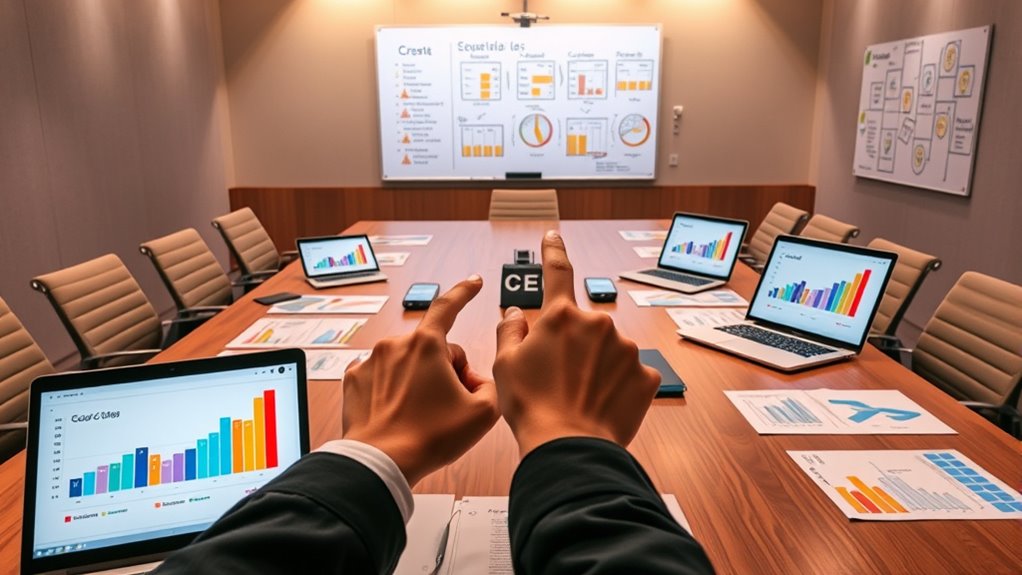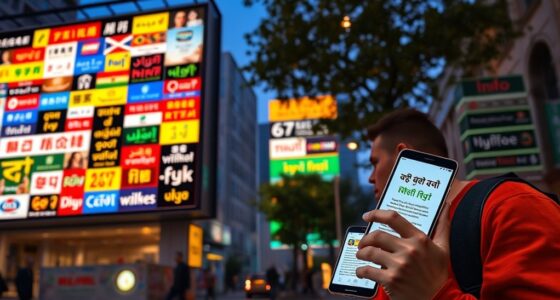To budget effectively for multi-language releases, you should balance localization quality, technology tools, and content scope. Focus on essential markets and prioritize core content to control costs. Use translation management systems and automation to boost efficiency while maintaining cultural nuance through human input. Plan for ongoing updates to avoid surprises and ensure relevance. If you keep these factors in mind, you’ll better manage expenses and ensure a successful international launch. Exploring more can help you refine your strategy.
Key Takeaways
- Prioritize target languages based on market size to optimize translation and localization costs.
- Balance automation tools with human expertise to reduce expenses while maintaining quality.
- Allocate budget for ongoing updates and maintenance to prevent unforeseen localization costs.
- Limit scope to core features initially, expanding to marketing and support content as budgets allow.
- Develop a clear localization strategy that aligns quality goals with cost management for multi-language releases.

Planning a multi-language release can be complex, but careful budgeting guarantees your project stays on track. When you’re preparing for a global launch, understanding the costs involved is vital, and that begins with developing effective localization strategies. Your approach to localizing content will directly impact your budget. For example, opting for a thorough localization strategy that includes cultural adaptation, market-specific adjustments, and precise language nuances can increase upfront costs but will pay off with better user engagement and fewer revisions later. Conversely, a more streamlined approach might save money initially but could result in subpar user experiences or the need for costly rework down the line.
Thorough localization strategies boost engagement but may increase initial costs; streamlined approaches save money but risk quality.
One of the most significant cost factors is translation technology. Investing in reliable translation tools—such as translation management systems, machine translation engines, and glossaries—can dramatically improve efficiency. These tools help automate repetitive tasks, reduce human error, and speed up the localization process, which translates into lower labor costs. However, it’s vital to balance automation with human expertise; certain content, like marketing copy or user interfaces, benefits from professional translation to preserve tone, intent, and cultural relevance. Incorporating translation technology thoughtfully into your workflow can help you control expenses without sacrificing quality.
Another key element to consider is the scope of your localization effort. Will you translate only core product features or expand to marketing materials, customer support content, and user documentation? The broader your localization scope, the higher your costs will be. Prioritize content based on its importance and potential impact on your target markets. Also, consider the languages themselves—some languages require more translation time and specialized expertise, which can influence your overall budget. For popular markets, investing in high-quality translation and localization strategies is often worth the additional cost, as it fosters trust and user satisfaction. Additionally, understanding the contrast ratio in your project can help ensure that localized visuals and interfaces are accessible and visually appealing across different markets.
Finally, don’t forget to account for ongoing costs. Localization isn’t a one-time expense. As your product evolves, you’ll need to update translations and maintain your localized content. Building a budget that allocates resources for continuous localization helps you avoid surprises down the road. When you plan ahead with clear localization strategies and leverage translation technology effectively, you’ll set a solid foundation for a successful multi-language release without overspending. This proactive approach ensures your international expansion is both cost-efficient and culturally resonant.
Frequently Asked Questions
How Do Translation Costs Vary by Language Complexity?
Translation costs vary depending on language complexity because more complex languages, with unique scripts or pronunciation, require specialized linguists and additional time. You’ll find that languages with rich linguistic nuance and cultural adaptation needs tend to be more expensive due to the extra effort needed to preserve meaning and context. Less widely spoken or simpler languages generally cost less, but investing in linguistic nuance can enhance user experience and authenticity, making it worthwhile.
What Are the Hidden Expenses in Multi-Language Release Budgets?
You should watch out for hidden expenses like localization pitfalls and cultural considerations, which can unexpectedly amplify your budget. These issues may require additional editing, quality assurance, or rework to ensure your content resonates correctly across cultures. Failing to plan for these factors can lead to costly delays or reputational damage. Always include a contingency fund for these hidden expenses to keep your multi-language release on track.
How Can I Estimate Costs for Future Multi-Language Projects?
Think of estimating costs for future multi-language projects as charting a voyage across diverse seas. You’ll need to account for cultural adaptation and localization strategies, which act like navigational tools. Start by researching target markets, estimating translation and adaptation expenses, and including contingency funds for surprises. Use historical data from past projects as your compass, and consult local experts to refine your estimates, ensuring a smoother journey ahead.
What Tools Can Help Manage Multi-Language Release Budgets?
You can use tools like Smartsheet or Microsoft Project to manage multi-language release budgets effectively. These tools help you streamline localization workflows and keep track of expenses in real-time. By setting up detailed budget tracking, you gain visibility into costs associated with translation, editing, and testing. They also enable collaboration across teams, ensuring everyone stays aligned and on budget throughout the project.
How to Balance Quality and Cost in Translation Services?
Imagine you’re localizing a game for multiple markets. To balance quality and cost, focus on cultural adaptation and prioritize key languages for high-quality translation. Use effective localization strategies like modular translation to save costs while maintaining authenticity. For example, investing more in culturally sensitive content guarantees better user engagement, helping you achieve quality without overspending. Always tailor your approach based on target audience needs and project scope.
Conclusion
By understanding the costs involved in multi-language releases, you can better plan and allocate resources effectively. Did you know that localizing content can increase your global sales by up to 30%? This highlights the importance of budgeting wisely for translations, voice-overs, and cultural adjustments. With careful planning, you’ll maximize your reach and return on investment, ensuring each release resonates with diverse audiences and boosts your overall success in international markets.









